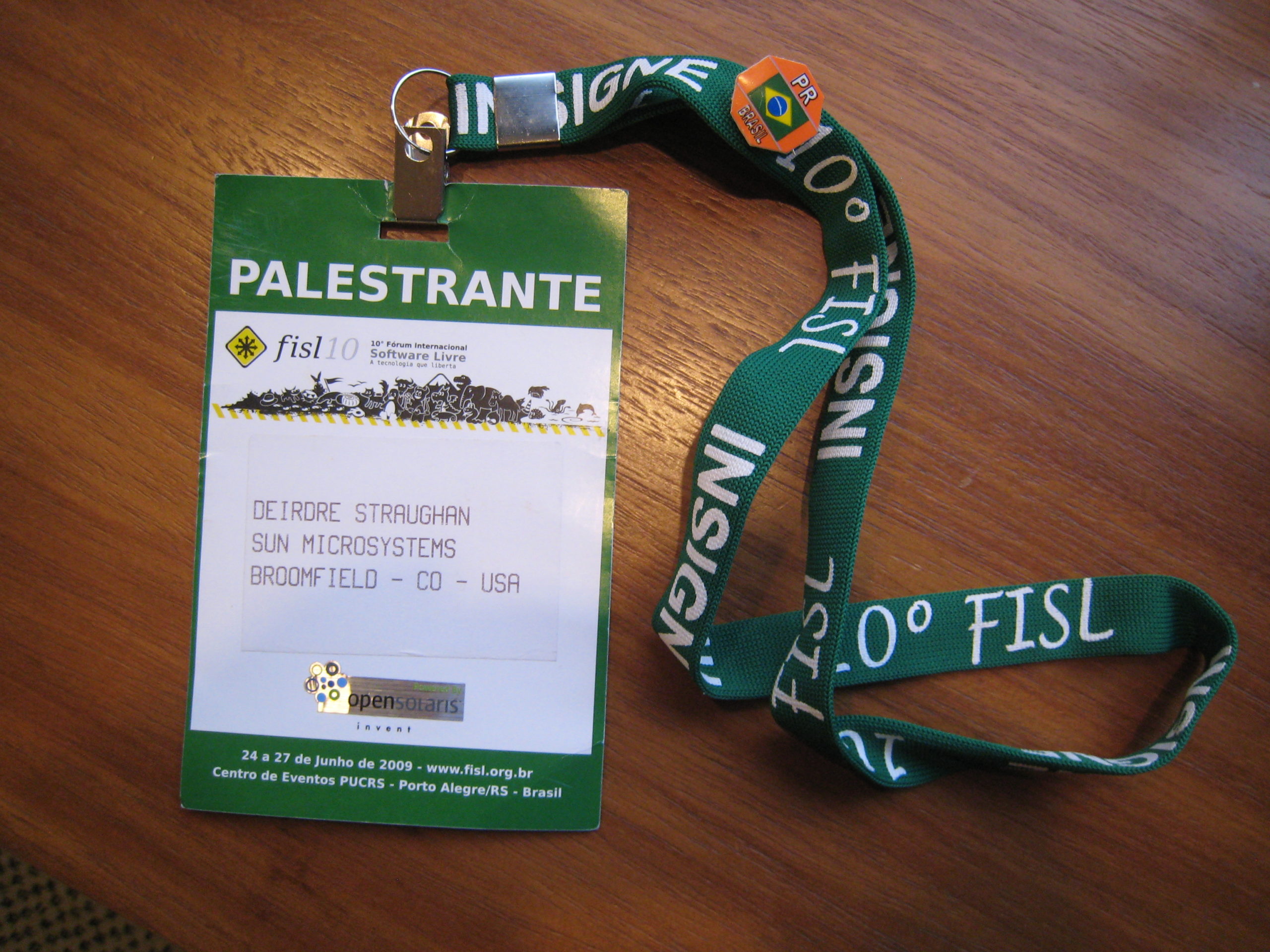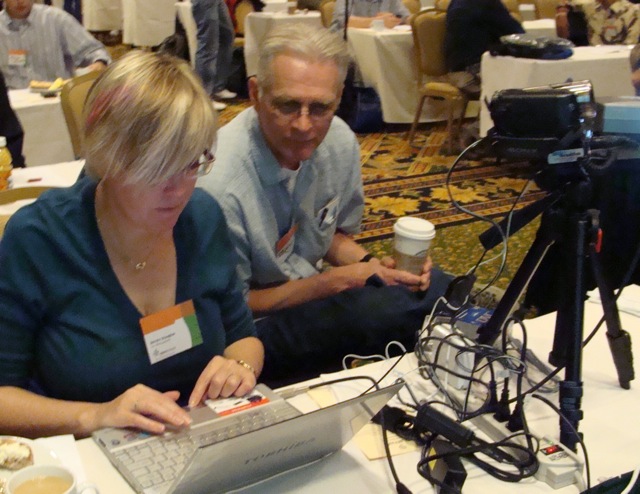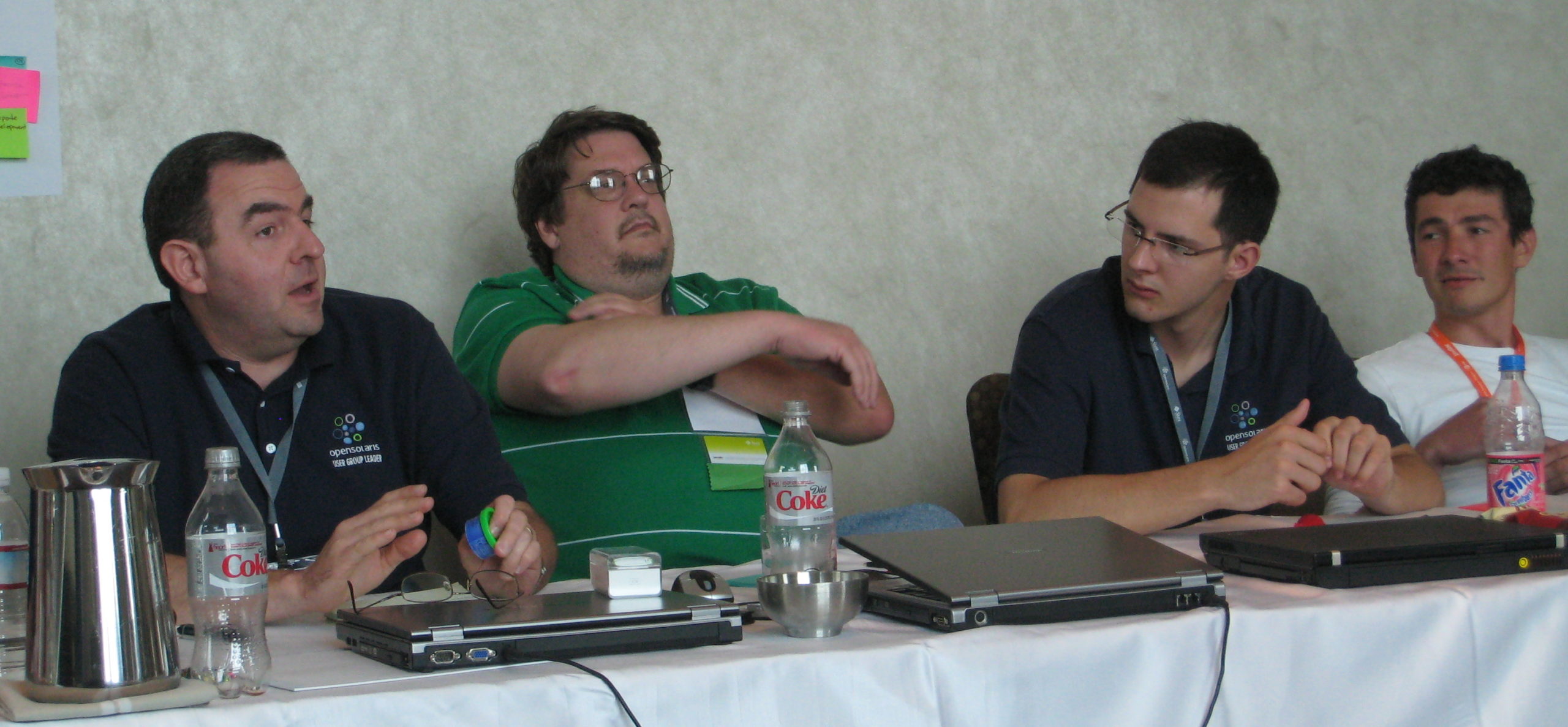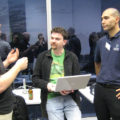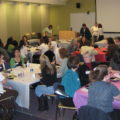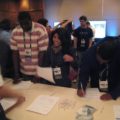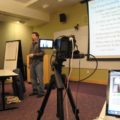I’m very proud of this: palestrante means speaker. FISL (this is the 10th edition) is one of the world’s largest open source conferences. The little orange button is important: PR stands for PRESIDENT. Which means I got to be one of the 300 people on the show floor when Brazil’s President Lula came to call, and was able to get pretty up close and personal among the mob. Video here.
Category Archives: what I do
Producing Social Media
Last week was a big one for Sun conferences, with CommunityOne on June 1st and 2nd, JavaOne starting on the 2nd. Like many other Sun folks, I was very busy with preparations in the weeks leading up to these, and played several different roles throughout conference week.
For some of us, C1/J1 were preceded on Sunday, May 31st by the Open High Availability Cluster Summit. Unlike our previous “specialty” summits for Open Storage, this one was organized mostly by the cluster engineering team themselves (though we of the community team like to think we’ve set a good example), who did a fantastic job of marketing it, achieving over 170 registrations.
They did ask me to cover video and social media for the summit. As I was doing it, I realized the job should be called “social media producer”. It’s more work than you might think.
In this case, I assumed my tasks to include:
- live video streaming of the talks (double tracks in the afternoon), with monitoring of any chat on the stream
- recording video for future editing and posting (NB: the video stream site can also capture the video, but the quality is poor)
- live-Tweeting the proceedings with the hashtag #ohac (why these tweets are no longer available via search.twitter.com is a mystery).
- assembling and managing a team who actually did most of the work (in part because I was ill, and not up to doing it myself all day as usual)
Room sound and lighting were handled by SWANK Audio Visuals, who were a pleasure to work with. I let them know in advance my requirements for camera position, with an Ethernet connection for video streaming and electricity for the camera, and found everything ready for me as requested Sunday morning. I set up my usual videoblogging gear, with the SWANK crew there ready to make the last-minute adjustments that are always needed.
Some things we figured out the hard way:
Unlike the the Open University’s FlashMeeting that I used for the last Open Storage Summit, UStream requires a separate feed for the audio, into the mic jack of the laptop you’re streaming from. [NB No longer true in 2012 with more recent UStream Producer software.] We took this from the sound board, but it needed an XLR grounding adapter (which, fortunately, the A/V crew had) to eliminate a very annoying hum. I was alerted to this hum by Mark Carlson, who was watching the stream remotely, via SMS – how many different forms of communication can I use in one day?
The fact that I learned about the problem from Mark tells me that it’s necessary to periodically monitor sound levels and quality into both the camera and the UStream. I used my iPhone headphones for this – not great, but better than nothing – or carrying around yet another piece of dedicated gear.
Another UStream gotcha: it requires you to press two different buttons to start broadcasting and start recording, whereas FlashMeeting simply stores everything that goes on during your broadcast. Because I wasn’t used to this, and not all of our ad hoc social media team had had the UStream training offered by Sun’s media team the previous week, we may not have hit the record button on every talk (don’t worry – we still have videotape).
UStream in its normal configuration includes a chat window which I had planned to use to encourage conversation among the online audience and to take questions from them. (It’s also useful for monitoring stream quality – people complain instantly on the chat if there’s a problem.) But for this event I was using the Sun UStream account, which, for reasons unknown to me, has disabled chat. All I could do was hope people asked questions via Twitter. No one did, which was disappointing – we had had good participation this way at the Open Storage Summit, with online questions to relay to the room for almost every talk.
I had one user contact me via email afterwards to complain that he had not been able to get the stream to work from his home. He’s an engineer and certainly knew enough to try it on various systems, so I’m at a loss to know what went wrong. Hoping the Sun media team can figure it out so it doesn’t happen again.
I had been so ill the week before that I wasn’t thinking clearly, and spaced on the fact that I’d need a laptop with a FireWire connector to connect the camera for the UStream, so I’d only brought along my MacBook Air (which, horribly, lacks FireWire). Fortunately, we had two Toshiba Portegé R500 netbooks along, which have FireWire and mic jacks and were easily set up to be our streaming stations. If I were to spec out a portable social media production station, one of these would be part of it.
What went well:
The C1/J1 conferences function, in part, as an opportunity for current and former Sun employees from around the world to gather and see each other. Everyone was looking for a reason to be there, so I had volunteers to help out with video and other social media tasks: Aaron Newcomb (who already knows his way around a video camera), Alan McLellan, and Alta Elstad – the Triple A team!
Alan and Alta attended the UStream training on Friday, so they were able to start and stop the UStream recordings for each session. They also jumped right in to live tweeting (using my Twitter account part of the time, hence all the activity) – as Sun tech writers, in fact, they were far more effective at this than I would have been.
Alan was confident enough to take over the videocamera in the main room so I could go rest (still ill), and Aaron arrived in time to run the camera in the second room in the afternoon. (I had hoped he would also do some video interviews on Monday, but he found himself disabled by an unexpectedly drained camera battery. Another lesson: always have a charged backup battery.)
Results:
- 8+ hours of video recorded (requests for it to be posted quickly started coming in the next day). Like most of the highly technical video I produce, the viewing statistics on this stuff may never look impressive. It’s certainly not viral video. But it will be immensely valuable – and most of it will remain so over time – to a select worldwide audience.
- Up to 9 or 10 people on the video streams at any given time – people who couldn’t join us in person were nonetheless able to participate. This number may seem small, but the conference itself wasn’t that big, maybe 150 attendees total.
- Lots of Twitter coverage
Costs:
- Time and effort by people who wanted to be there because they had direct interest and expertise, and didn’t have to be paid (extra) to do the social media work. All parties benefited.
- (My) time to produce the event, then edit, post, manage, and measure the final video.
I’d call that a fair return on investment.
photo at top: me and Alan, hard at work (photo by Lynn)
Gallery: OpenSolaris User Group Bootcamp
Upcoming Speaking Engagements
Somewhat surprised to find myself with such a list:
- June 17, Chicago: at Executing Social Media for Internal Communications I will be part of a panel (of three) on UTILIZING SOCIAL MEDIA TOOLS TO BUILD ENGAGEMENT AND COMMUNITY
- June 25, Porto Alegre, Brazil: at FISL Aaron Newcomb and I will be speaking on Using Video to Communicate About Open Source Software
- July 6-8, Wellington, New Zealand: three workshops at the Ministry of Education (open to anyone) on Extending Conversations Through Social Media. Likely Tweetup or other gathering to occur one of those evenings!
And I’ll be doing a poster on videoblogging at the Grace Hopper Celebration of Women in Computing in October.
The Things I Do at Sun: Video
My official job title at Sun is, I believe, the vague and essentially meaningless “Program Manager.” My Sun business cards say I’m a “Community Specialist and (Video)blogger”. I made that up in a hurry, and wish I could find something more descriptive. But it has long been the story of my professional life that what I do, even within any single job, is usually hard to explain in a few words or a standard job title.
People do keep asking, though, so I’ll take a shot at explaining just what it is I do for Sun, and why.
When I was originally hired as a contractor by Dan Maslowski nearly two years ago, my task was to help his group of engineers produce web content (I believe they had deliverables about that at the time, handed down from on high).
We thought this would mean white papers and blog posts, so I did the training necessary to be able to edit official Sun documents (you have to know a lot about trademarks). I then spent a lot of time begging engineers to write white papers and blog posts, including weekly meetings in which we all solemnly agreed that these things needed to be done. But everyone was too busy writing code to write about the code they were writing, right?
I couldn’t do it myself. I have at times been a tech writer (and a good one), but it would have taken me years to achieve the level of knowledge I’d need to write usefully about this deep technology. (Of course there are folks at Sun who have this knowledge, because they have been doing it for years; they are already up to their eyeballs in writing documentation.)
So how could we get vital information out of busy engineers and make it available to those who need it, both within and outside of Sun? We needed to find another way.
Upon hearing that I knew something about video, Dan and Scott had bought me a videocamera. In August, Dan hauled me out to Colorado to film five days of training his staff were giving on the Leadville stack (storage software). This resulted in hours of video about the nitty-gritties of things like MPxIO. The audience for this kind of thing isn’t huge, but they are dedicated: it appears that about 150 people (so far) have gotten through all three hours of this presentation!
SNIA’s annual Software Developers’ Conference that September (2007) featured many Sun speakers, but there were no plans to film it: Sun’s preparation, travel, and expense would bear no fruit beyond the (relatively small) conference audience in San Jose. So, with SNIA’s blessing, off I went to film it, with Sun colleague Ray Dunn manning a second camera to cover simultaneous tracks. That resulted in about 12 hours of finished video, which can be seen on Storage Stop.
From there, this video thing has snowballed. I’ve now filmed at: Sun Tech Days (Milan), SNIA Winter Symposium, SNIA Storage Security Industry Forum, USENIX FAST, Storage Networking World, OpenSolaris Developers’ Summits (Santa Cruz and Prague), CommunityOne, Open Source Grid & Cluster Summit, Sun’s HPC Consortium (Dresden and Austin), International Supercomputing Conference, an analyst round table, Open Storage Summit, SNIA SDC 2008, various Sun internal conferences, LISA, SC08, and Sun offices in Menlo Park, Eagan, Bangalore, Dublin, Grenoble, Guillemont Park, and London… so far.
More importantly, the videoblogging “gospel” has started to spread at Sun. More people have realized that it’s possible to produce useful video, quickly and cheaply (some were already doing it completely independent of me). It doesn’t have to be a big deal, and many Sun offices and individuals already have most or all of the equipment they need. I still do a lot of video work myself directly, but others are now eager to learn. I’ve been sharing my know-how as best I can (and plan to do more, in this blog and in person), and am working with other Sun folks (and others) interested in media to do even more. Let a thousand vloggers bloom!
…but video, though it takes up the bulk of my time, is not the whole story of what I do at Sun. More to come!
see also: The Things I do at Sun: Events

